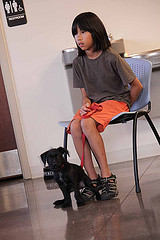Many children (and some adults) will get their ultimate holiday wish fulfilled this Christmas or Hanukkah, and receive a puppy as their present. It seems great – the recipient gets a new best friend and the dog gets a home just in time for the holidays.
But what happens to that puppy when the cuteness wears off come January? Do the parents still think that gift is cute when it’s chewing their Prada purse or Italian leather shoes?
What about when he becomes a teenager and suddenly stops listening? It’s no coincidence that the majority of dogs in shelters are either senior or teenaged dogs.
Help prevent the influx of Christmas puppies in your local shelter by following these tips before and after bring that bundle of joy home.
Before You Bring Her home
Andrea Servadio, co-founder of Fitdog Sports Club, a full service doggy daycare located in Santa Monica, Calif., says one of the biggest issues is people outside of the immediate family giving a dog as a gift.
National Council on Pet Population Study (NCPPS) and Policy found that “Animals acquired from friends were relinquished in higher numbers (31.4% of dogs; 33.2% of cats) than from any other source.” (See full report here).
Even if you know the family’s child wants a dog desperately, and you think your friend is just being “unreasonable,” don’t do it. The only one that will really suffer in this situation is the unwanted dog.
Instead, have a conversation with your friend’s and then let them decided whether they want to get their child a dog. If they say no, buy him a stuffed one instead. If he is old enough, suggest he volunteers with a local shelter or rescue to get some “dog time.”
Money.
Servadio says a lot of times people underestimate the cost of having a dog, or are not financially prepared. According to the ASPCA, the first year can cost up to $1,800 including vet bills.
Time.
“People underestimate the time requirements of having a dog,” Servadio explains. “Dogs aren’t toys that can be played with at your convenience. They demand meaningful love, care and interaction from you. Adopting a dog requires a lot of consideration and work. They are not impulse purchases or gifts for friends.”
Choosing Well.
Finally, she explains that many people chose the wrong breed for their lifestyle.
“Boxers are popular, but not apartment dogs,” she explains. “Get a lap dog, like a Cavalier King Charles, and if you don’t like small dogs, then don’t get one.”
Often, people choose based on looks or what a favorite character on a show has for a pet, instead of what fits their family.
If You Get a Puppy

Once you have decided to get a puppy, there is still that risk that he will end up at a shelter in a few months. In fact, according to the NCPPS, most people give up before the dog turns 2 years old.
Mychelle Blake, MSW, CDBC, CAE, Chief Executive Officer of The Association of Professional Dog Trainershas the following tips to ensure your puppy stays with you after his first Christmas, until his last.
- Puppy socialization is critical to developing a happy, healthy adult dog. Locate a good puppy class in your area and take your puppy as soon as possible! Visit Apdt.com to find classes in your area.
- Socialization shouldn’t just happen at class. Take your puppy out with you as much as you can – on road trips to the bank, to the vet for short visits to acclimate them to the clinic, and to places where dogs are allowed like pet stores, hardware stores, etc. You want your puppy to meet as many people and experience as many places as possible. If you have friends with dogs that are well behaved and vaccinated, you can also set up some play meetings to get them used to other dogs.
- Training doesn’t need to wait for class either. You can start teaching your puppy the rules of the house immediately and it doesn’t take a lot of time. Ask the puppy to sit for his dinner, by the door if he wants out, or for anything he wants. You can start teaching basic behaviors right away and it not only helps the puppy learn what you want but it also helps to build your bond and relationship.
- The easiest way to effectively house train your puppy is to use a crate. APDT has free resources on our site to help with house training – here and here.
- Plan for the next few months! Your puppy is going to be going through a lot of changes which will include teething, excessive chewing, probably destructive behavior, and other very common issues. Make sure you have an adequate plan for containment when you are not home (such as a crate or baby gates), ample types of chew toys and items for her to play with, and a plan for how you will properly exercise her. The more you are ready for what comes next, the more raising a puppy will be a breeze.
About the Author
Based in Wilsonville, Ore., animal lover Kristina N. Lotz is a Certified Professional Dog Trainer – Knowledge Assessed (CPDT-KA) and works as a full time trainer. She is the founder of A Fairytail House, a unique all-positive all-sport dog training facility that helps rescue dogs in her area and provides free seminars and training classes for the community. In her spare time, she trains and competes in herding, agility, obedience, rally, and conformation with her Shetland Sheepdogs. She smartly married a Veterinary Technician, who helps keep the fur kids happy and healthy, and provides a quick resource for articles.
